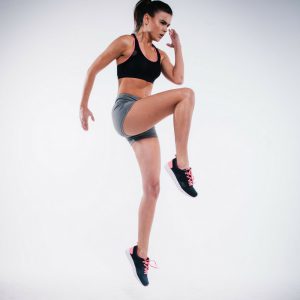Improve Your Running Efficiency
Want to run faster while using less energy? Here’s how to train your body to up your running game and improve your running efficiency!
With the colder months now here, its officially running season again! Whether you’re just getting into running, hitting

up parkrun each week, or having bigger events like the city2surf, or even a marathon, here are a few simple ways to improve your running efficiency.
First things first…..
Don’t run heels first! Stop, and read that sentence again, Don’t run heels first!
Save that for walking
Why you ask?
Running with a heel landing can contribute to back and knee pain.
Landing on your forefoot (instead of your heels) allows your muscles to catch the weight of your body in flight, reducing the effects of impact on the joints and bones.
It will feel awkward at first, but stick with it and we’ll look forward to receiving all of the thank you cards once it all clicks!
Okay. So here it is…work on these 3 areas and improve your running efficiency immediately
Get Stronger

This doesn’t just mean targeting your legs, you have to strengthen the body as a whole or there will be imbalances – ever seen a sprinter with no upper body or a marathon runner with tree trunks for legs? It doesn’t happen, they are always in balance.
It’s not uncommon for runners to acquire muscle imbalances that create more work for the body when we ask it to run or move (inefficiency). In fact, even runners that strength-train regularly can fall victim to muscle weakness if they’re not addressing the imbalances directly.
For example, prolonged sitting can cause the glutes on both sides to weaken or shut off, causing instability and lateral shifting in the hips. This weakness hinders your running form via wasted lateral movement and can also cause overuse injuries like Iliotibial Syndrome and other issues down the chain.
Get your power on
 Adding plyometrics into your regular routine will boost strength and speed by improving the elasticity of the muscle via the stretch-shortening cycle. That is, when the muscle is stretched before an explosive contraction, like bending through the knee before a single leg jump, it contracts more powerfully and quickly.
Adding plyometrics into your regular routine will boost strength and speed by improving the elasticity of the muscle via the stretch-shortening cycle. That is, when the muscle is stretched before an explosive contraction, like bending through the knee before a single leg jump, it contracts more powerfully and quickly.
Because these exercises are explosive in nature, it is best to weave them into your program after you have established a solid base of strength-training, once per week, and in rotation with your strength-training program. Perform these exercises after your runs to focus on good form, as performing plyometrics with sloppy form can quickly lead to injury. Here are three plyometric exercises for runners. By the way, plyometrics are a little like child’s play once you get the hang of it.
- Power skips: Keeping your arms in running form, skip for a total of 20 on each leg, focusing on landing lightly on the balls of your feet and increasing the height of each skip.
- Leg bounding: With an exaggerated running form, bound forward by jumping with each stride, focusing on an exaggerated knee lift for 20 seconds. Walk back to recover and repeat 2-3 times.
- Squat jumps: Stand with your feet shoulder-width apart and bend into squat position with your hips back and knees bent. Tap the floor with your hands and jump up reaching your hands to straight over your head. Bend your knees as you land, touch the ground again, and repeat for 20 seconds.
Improve your stride rate
What the hell is stride rate?
Your stride rate is simply the number of steps you take in a minute.
To find it, count the number of strides on one foot for one minute and double it – simple right! The goal is to have a stride rate of around 180, or 90 per foot. If it’s much less than that, it likely means you’re creating more vertical energy, projecting more upward motion than forward, and you guessed it, wasting energy!
It also means you’re employing braking forces with every stride rather than rolling quickly over the ground. The key is to practice patience while increasing your stride rate and decreasing the time you spend on the ground. Remember as a kid when you used to pretend the ground was lava? Use that mindset next and every time you hit your next run.
To improve your stride rate, you can :
- pick a song that sits at around 180 bpm,
- invest in a metronome (musician’s timing device), or
- add the following drill to the beginning or end of your runs (it makes a great active warm-up).
Run on the spot – cadence drill
- Stand with your feet shoulder-width apart. Position your arms and hands as though you were running. Run in place as fast as you can, bringing your knees halfway up. Make sure your knees are pointing straight ahead and your heels are not touching the ground.
(for the first few times, stand in front of a mirror and check out your technique – you need to visualise what it feels like to run properly. The more you practice the more it becomes second nature) - Run for 20 seconds, counting the number of times your right foot strikes the ground and then rest for one minute. Repeat the drill two more times. Perform this drill a couple times per week. Make note on whether the number of times your right foot hits the ground increases. With this drill, you are teaching your feet to get off the ground as quickly as possible. Which translates into a faster cadence!
Although this drill (and running with a faster cadence) may feel awkward at first, that just means you’re creating new neuromuscular patterns that will soon start to feel more natural. When running to music or a metronome, it’s best to focus on taking shorter strides and increasing the cadence gradually. If your stride rate is 170, for example, you could set it to 174 and progress slowly from there.
All in all, It’s important to remember that Rome wasn’t built in a day, and optimal running efficiency isn’t, either. The good news is with a little time invested in these exercises can make a significant difference in your running performance down the road.
So what are you waiting for! Lace up those shoes and see what these exercises can do for your running game! Or better yet, book yourself into our Stride class on every Wednesday at 5.30pm and have Chris run you through your paces!
